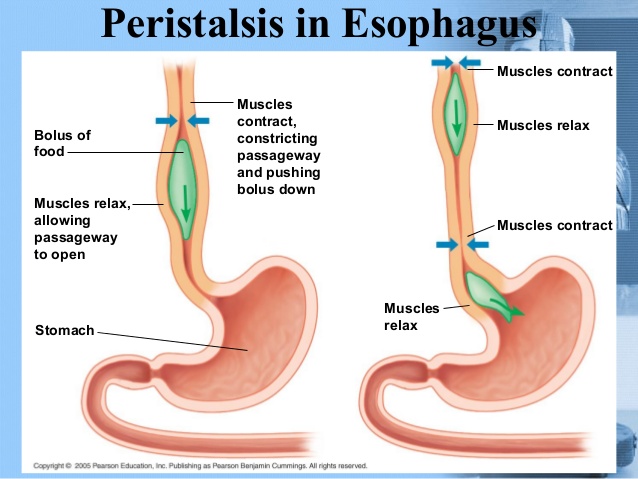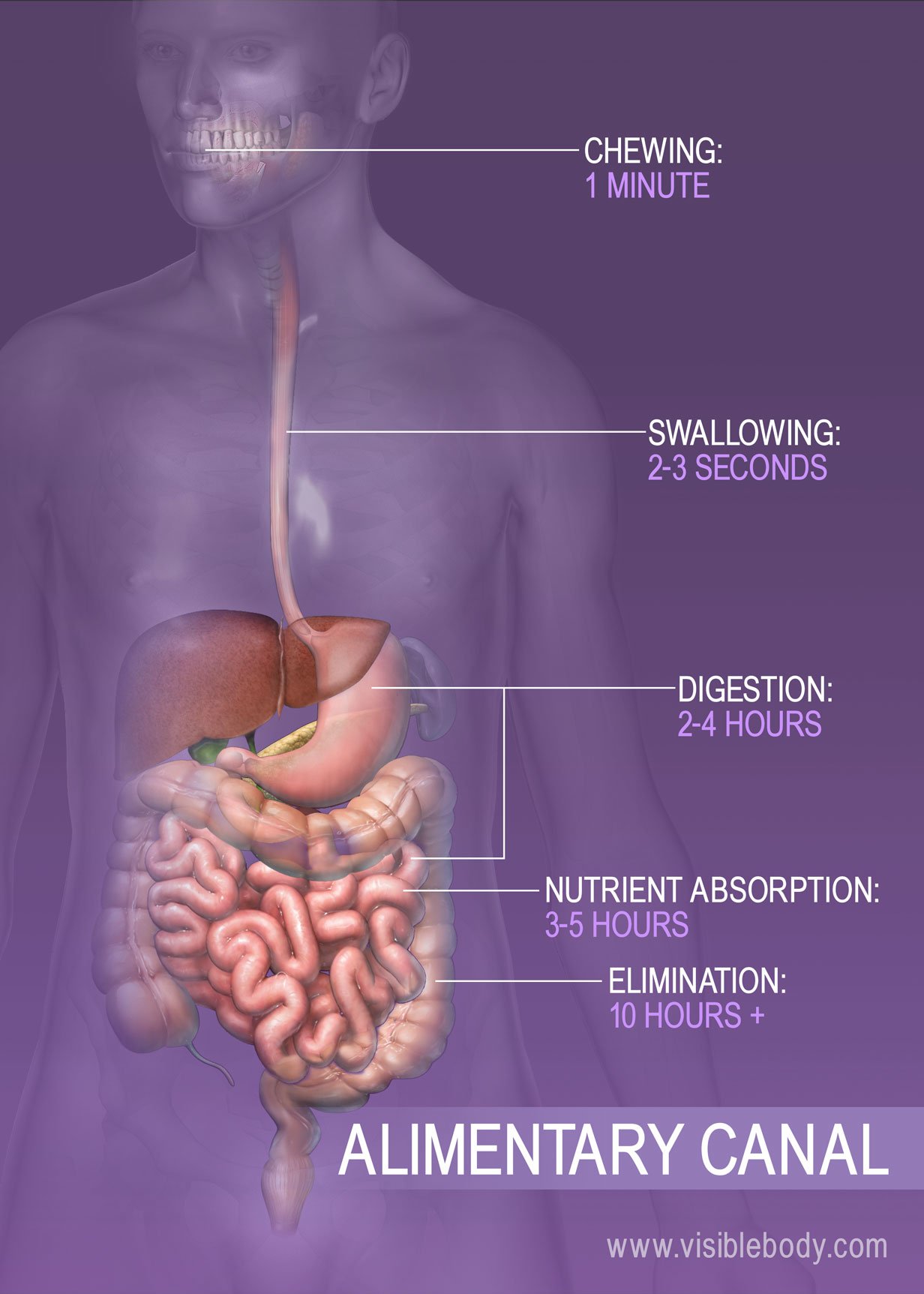Describe How Peristalsis Moves Food Through the Digestive Tract
The large hollow organs of the digestive tract contain a layer of muscle that enables their walls to move. Peristalsis is a series of wave-like muscle contractions that move food through the digestive tract.

What Is The Process That Moves Food Through The Esophagus Socratic
This act of swallowing the last voluntary act until defecation is an example of propulsion which refers to the movement of food through the digestive tractIt includes both the voluntary process of swallowing and the involuntary process of peristalsis.

. It begins in the esophagus and continues in the small intestine and later in the large intestine. Food through the digestive system. Food is taken in through the mouth and chewed masticated.
Peristalsis Is the Contraction of Muscle Tissue That Helps Move and Break Down Foodstuffs The. It also occurs in a reverse pattern in cattle like cows buffaloes etc. Circular muscles - which reduce the diameter of the gut when they.
Food starts to move through your GI tract when you eat. It can face the. Peristalsis in the digestive tract begins in the esophagus.
Movement of Food Through the System Typical movement of the esophagus stomach and intestine is called peristalsis. Chemical characteristics of food are not changed by mechanical digestion. Food leaves the mouth when the tongue and pharyngeal muscles propel it into the esophagus.
After food is swallowed it is moved down the esophagus by peristalsis. This act of swallowing the last voluntary act until defecation is an example of propulsion which refers to the movement of food through the digestive tractIt includes both the voluntary process of swallowing and the involuntary process of peristalsis. Food is moved through the digestive system by a process called peristalsis.
How Food Moves Through the Alimentary Canal 1. This occurs when the pyloric sphincter a ring of muscle at the bottom of the stomach relaxes and lets the food flow through. The food is instead made smaller so that it can move.
It starts in the esophagus where strong wave-like motions of the smooth muscle move balls of swallowed food to the stomach. Peristalsis is an automatic and important process. This coordinated contraction of smooth muscle keeps food moving on its one-way path through your digestive system.
Peristalsis moves food through the digestive tract with alternating waves of muscle contraction and relaxation. Here the churning of the stomach makes the food into a substance called chyme. In each organ this process helps movement and absorption of food through the digestive tract.
Food leaves the mouth when the tongue and pharyngeal muscles propel it into the esophagus. Then peristalsis moves the digested food through the small and large intestine and then through the rectum and anus. The muscle behind the food contracts and squeezes the food forward while the muscle in front of the food relaxes to allow the food to move.
Peristalsis is a normal function of the body. There are both chemical and mechanical processes involved in digestion. This process works even if you stand upside down.
The muscles in the lining of these organs contract and relax from above the food which pushes the food downwards. Describe how peristalsis moves food through the digestive tract. Food is further digested and broken down as it moves through the digestive tract aided by digestive juices that are.
It is a series of smooth muscle contractions and relaxations moving food in a wave-like manner through the different. These rhythmic wave-like movements are created by peristaltic muscle contractions which are located within the walls of your digestive tract. Food moves from one organ to the next through muscle action called peristalsis.
Additionally peristalsis helps mix food and digestive juices. The chyme is moved along the alimentary canal via peristalsis and the organs allow entry of the chyme due to the relaxation of the sphincters. The muscles in the stomach small intestine and large intestine continue the process.
Peristalsis can sometimes be felt in your belly abdomen as gas moves along. Peristalsis is a series of involuntary wave-like muscle contractions that help in the movement of food along the digestive tract. The role of peristalsis in the digestive system is that it is the way food is propelled down the esophagus and into the stomach.
The movement of organ walls can propel food and liquid through the system and also can mix the contents within each organ. The digestive process starts when you put food in your mouth. In simplistic terms it means moving food and liquids within the body from one place to another.
The muscle of the organ produces a narrowing and then propels the narrowed. Peristalsis in the Digestive Tract. For a medium-sized bolus it takes about 58 seconds to reach the stomach.
The Epiglottis Directs Swallowed Foodstuffs Down the Esophagus The respiratory and digestive systems share structures. There the food is churned into a liquid mixture called chyme that moves into the small intestine where peristalsis continues. Peristalsis moves food through the digestive tract with alternating waves of.
Through this article we understood that peristalsis plays a very important role in the digestion of food in animals and also in human beings. Peristalsis is used to describe the movement of food through the digestive tract. After passing through the small intestine.
Segmentation Peristalsis is what moves food along the small intestine but we. Once swallowed the food passes into the stomach. Also question is what moves food through the GI tract.
Bile from the gallbladder into the duodenum. In the center image the food bolus and the wave movement are closer to the center of the esophagus and in the right image the bolus and the wave are close to the bottom end of the esophagus. Urine from the kidneys into the bladder.
Peristalsis is so powerful that even when you re standing on your head food and liquids will enter your stomach. The action of peristalsis looks like an ocean wave moving through the muscle. Food is mixed with gastric juice.
Two sets of muscles in the gut wall are involved. The movement pushes food and liquid through your GI tract and mixes the contents within each organ. The partially digested food now referred to as chyme is then pushed through the small intestine by rhythmic wave-like muscular contractions of the involuntary smooth muscle in the intestinal walls.
Click to see full answer. 7 rows Figure 1. In the oesophagus the bolus is moved along by rhythmic contractions of the muscles present in its walls.
Where does peristalsis occur. Peristalsis is a process of muscle contraction and relaxation which facilitate the movement of the food along the digestive tract.

Stomach Peristalsis Movement Of Food Through The Small Intestine Youtube

Definition Of Peristalsis Find Out Where Peristalsis Occurs In The Digestive System What Is Digestive System Anatomy Digestive System Human Digestive System
Comments
Post a Comment